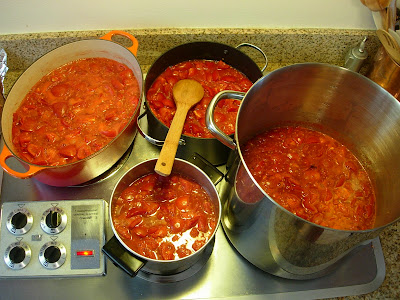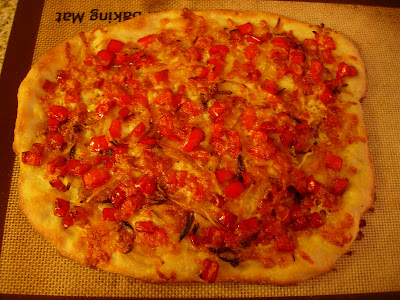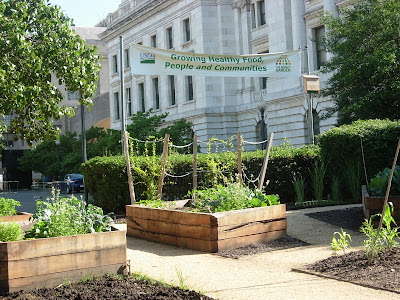Tuesday, September 29, 2009
Trial to improve Market Street goes well...
As I mentioned in an earlier post SF's main artery, Market Street, isn't working for anyone--walkers, bikers, bus riders, or car divers. Today was the first day of a pilot project to change that reality. Cars headed downtown on Market street were required to turn right on 8th and 6th streets, leaving Market congestion free for faster bike and bus commutes! Initial reports indicate that the world did not come to a halt, nor did traffic on other streets. And in fact, everyone seems to be excited about it. Looking forward to seeing how this trial plays out.
Last Chance: Become Slow Food USA member at any $$
Join Slow Food USA at any price until Oct. 1! I've always wanted to support SFUSA at the membership level, but it's always been a little too pricey--this is a great opportunity to support a good cause.
Thursday, September 24, 2009
Park(ing) Day 2009: a missive from Thomas
A welcome post by my friend, fellow urban farmer & We Walk to Work organizer, Thomas Vogl:
5 of us ventured out on Park(ing) Day morning to find a nice metered parking spot on Haight Street. Yes, we had in mind to feed the meter, but not to park a car. Park(ing) Day, a worldwide phenomena, is about re-thinking the use of public space, specifically street parking spaces. If you legally lease a space (by feeding the meter), why couldn't you put it to a different, better use?
In our case, we decided to create a little cozy living room and invite friends and whoever would pass by. Right on Haight Street (and Clayton). We decorated everything nicely with plenty of plants, put down some blankets, rugs, and cushions, and sat down to relax, and were curious to see what would happen.
Lots of people seemingly had no idea what to think about us. But almost everyone was curious enough to stop and investigate. One of the most wonderful things about that day - was that some people stopped in their tracks, and started talking. Some people took the time to take their shoes off and sit down with us.
On a physical level, sitting on the street gives you a really different perspective. Cars, and especially trucks, feel even more intimidating and dangerous. And you're even closer to the noise and exhaust fumes they are emitting. Oh, time to get up, and feed the meter again (let's keep it legal :) ). One of the best moments this morning - when a group of hippies stopped, and we told them what we were doing. their immediate reaction: "Sitting on the street? you must be joking? We so do that!" Could that be the first humble beginnings of turning Haight Street into a pedestrian area?
After lunch Adam and I ventured out to check out some other places on Valencia Street. Several 'parks' spread out along 10 blocks. Everything from a simple sitting area, to real grass with deck chairs and trees. The Bicycle Coalition took the opportunity to test bicycle on-street parking (bicycle racks on a parking spot rather than on the side walk). And everywhere the same playful and neighborhoodly atmosphere of chatting and having fun together.
Adam and I at one point got cocky, grabbed our chairs, and sat down right in the center lane of Valencia Street. 2 very interesting observations:
- a street occupies a lot of space.
- almost immediately cars slowed down! I guess they didn't know what to expect from us. Another way of traffic calming :)
An almost perfect day, and I can't wait for the next Park(ing) Day! But why wait until next year? Everyone of us can 'park' her/himself, on any day! Happy Park(ing)! :)
A White House Farmers' Market?!
It isn't just a farmers' market. It is healthy food, low carbon farming, local economies and community. Learn more about this historic event and see how a movement gains speed here.
Monday, September 21, 2009
More food preservation in action
In addition to the buckets of tomatoes--I also tried out preserving my favorite summer herb basil. I had 10 bunches to deal with. Day one I decided to freeze some of the little ones that wouldn't make it through the night. I had no clue what I was doing and chopped them up in a food processor with tons of olive oil. It actually worked! My pesto making adventures the next night didn't go so well...it was the victim of massive freezer burn!

Friday, September 18, 2009
Food Firsts: Freezing Summer's Harvest
Every winter as I open can after can of organic tomatoes, I think back to summer's unparalleled fresh tomatoes. Every winter I promise to preserve the summer's bounty. Since I've declared this year as my year of doing not talking, I've been trying it out....
I started with a canning class at the Studio for Urban Projects and followed up with big tomato orders from Mariquita's Ladybug Buying Club. I love the Ladybug Buying Club--you can pick up bulk orders of your favorite things like Padron peppers, basil, and of course, tomatoes!
My friend Edna and I jumped in with a first order of 20 lbs of San Marzano romas. Then upped it to 40 lbs of Early Girls and added another preservation newbie, Tanya.
Instead of investing in canning equipment, we invested in freezer bags and tried both food milling some sauce and roasting up individual tomatoes. While we don't have enough tomatoes to last us through the winter, we learned a lot and had more fun than I imagined. And tomato season isn't over yet...
Here's a step-by-step to get you through. BTW make sure you have a full afternoon ahead of you as this can take a few hours!
Cooked tomatoes: a good base for sauce and substitute for canned tomatoes.


Tips:
I started with a canning class at the Studio for Urban Projects and followed up with big tomato orders from Mariquita's Ladybug Buying Club. I love the Ladybug Buying Club--you can pick up bulk orders of your favorite things like Padron peppers, basil, and of course, tomatoes!
My friend Edna and I jumped in with a first order of 20 lbs of San Marzano romas. Then upped it to 40 lbs of Early Girls and added another preservation newbie, Tanya.
Instead of investing in canning equipment, we invested in freezer bags and tried both food milling some sauce and roasting up individual tomatoes. While we don't have enough tomatoes to last us through the winter, we learned a lot and had more fun than I imagined. And tomato season isn't over yet...
Here's a step-by-step to get you through. BTW make sure you have a full afternoon ahead of you as this can take a few hours!
Cooked tomatoes: a good base for sauce and substitute for canned tomatoes.
- Wash & coarsely chop your tomatoes
- Put a tiny bit of water in the bottom of a large stock pot, add the tomatoes and cook for about 30-45 minutes until they begin to breakdown
- Process through a food mill--the tinier the setting the less skin and seeds you get, but the more watery your sauce.
- Cook processed tomatoes for another 45-1hour Add a bit of basil, salt and pepper--just to give it a good base to make a great sauce later on.
- Let it cool completely.
- Fill freezer bags with the sauce--make sure to get all the air out or else you'll become a victim of freezer burn! From 20 lbs of tomatoes we ended up with about 4 large freezer bags full of sauce.
Perfect twin tomatoes.
Edna's beautiful pizzas that got us through the sauce making. Roasted peppers + carmelized onion. Yum.
Tips:
- Food preservation is best done in the company of good friends, with some good wine and delicious snacks along the way.
- Before choosing your technique, carefully consider your tomato. This is what I've found to work so far: Roma=roasting or cook into sauce, Early Girl or other deliciously juicy variety=cook into sauce or can whole.
- Next time I'm going to try peeling and freezing them whole--I think this may take less time...we'll see.
- If you're canning -- just peel and can the whole ones, it's just too much work otherwise.
- To save $$ find a local, organic pick-your-own spot. It turns food preservation into
- Be prepared to have your dreams overwhelmed by tomatoes. It's true.
- Any advice from other tomato preservationists? I'm battling a bit of freezer burn--would love some tips on that front!
Friday, September 11, 2009
Gardening gets political
With food policy reform hitting the national scene big these past couple of weeks--from the national Time for Lunch campaign about making school food good to Micheal Pollan's wildly popular NYT article connecting the dots between health care reform and food policy--I decided it was a great time to dust off these photos I took in DC in June and post them.

Urban community gardens are becoming part of the landscape at our most important public buildings. There are raised veggie beds on the White House south lawn. And Tom Vilsack has put a community garden front and center at the USDA's headquarters.
I stumbled this special garden when I visited our nation's capital a couple of months ago in the late afternoon sun. While these photos may not be my best, they capture a special moment of excitement for me when I felt that my own passion for urban community gardens is connected to a larger movement.
 It is a mistake to place too much value on these new gardens in and of themselves--but they are not merely a green facade either. These gardens will sow new food policy and usher in a new culture of slow food traditions. They are a symbol that a message has reached the highest level of our halls of government--people want to reinvest in our soil, to begin to connect to good, healthy food again.
It is a mistake to place too much value on these new gardens in and of themselves--but they are not merely a green facade either. These gardens will sow new food policy and usher in a new culture of slow food traditions. They are a symbol that a message has reached the highest level of our halls of government--people want to reinvest in our soil, to begin to connect to good, healthy food again.

For a food advocate like me, it offers up a glimmer of hope. I see an opening. If healthy veggie gardens greet our decision makers, it's the first tool in educating them about good food and growing it yourself. I'd love to see these community gardens in front of all of our public buildings. If it can be done at the White House it can be done at your City Hall.
Urban community gardens are becoming part of the landscape at our most important public buildings. There are raised veggie beds on the White House south lawn. And Tom Vilsack has put a community garden front and center at the USDA's headquarters.
I stumbled this special garden when I visited our nation's capital a couple of months ago in the late afternoon sun. While these photos may not be my best, they capture a special moment of excitement for me when I felt that my own passion for urban community gardens is connected to a larger movement.
For a food advocate like me, it offers up a glimmer of hope. I see an opening. If healthy veggie gardens greet our decision makers, it's the first tool in educating them about good food and growing it yourself. I'd love to see these community gardens in front of all of our public buildings. If it can be done at the White House it can be done at your City Hall.
Thursday, September 10, 2009
Making good on Transit First: A Market St. Pilot
Market street isn't working well for anyone--bikes and pedestrians have to dodge cars and buses, while buses get slowed down by traffic. A group of diverse stakeholders are working together to make Market street better--a place to be.
Starting September 29th a series of pilot projects will be aimed at reducing traffic on Market street in the downtown corridor coupled with street improvements like turning sidewalks into plazas and having more music on the street.
I can't wait. Read more about it here.
Starting September 29th a series of pilot projects will be aimed at reducing traffic on Market street in the downtown corridor coupled with street improvements like turning sidewalks into plazas and having more music on the street.
I can't wait. Read more about it here.
Pollan connects the dots: Health care & food policy
Check out Micheal Pollan's latest NYT article on the linkages between food policy and health care reform here. It's all connected...
A notable quote:
"According to the Centers for Disease Control and Prevention, three-quarters of health care spending now goes to treat “preventable chronic diseases.” Not all of these diseases are linked to diet — there’s smoking, for instance — but many, if not most, of them are.
We’re spending $147 billion to treat obesity, $116 billion to treat diabetes, and hundreds of billions more to treat cardiovascular disease and the many types of cancer that have been linked to the so-called Western diet. One recent study estimated that 30 percent of the increase in health care spending over the past 20 years could be attributed to the soaring rate of obesity, a condition that now accounts for nearly a tenth of all spending on health care."Saturday, September 5, 2009
Cook Food: A book I want to buy by the box-load
I picked up Cook Food, a manualfesto for easy, healthy, local eating the other day and experienced something completely unprecedented: I had the desire to purchase this little gem by the box-load and give it away to all my friends, maybe even to strangers on the street corner.
What inspires such a feeling? This cookbook epitomizes all that is central to my cooking and eating style in a simple, concise way all for the low price of $10. It is about real, local, fresh food. It is not about elitism. It doesn't shy away from politics. It tells you what you need in your kitchen arsenal, everything from the raw materials to the hardware. It's funny. It can practically fit in your back pocket. It has simple suggestions for how to eat breakfast, lunch, and dinner, (yes sometimes we all need a reminder on how to make these three meals great).
But really, when I saw that the first three recipes are different versions of greens & beans, I was head over heels.
This book makes cooking accessible and approachable for even the most novice of cooks--and has simple recipes to learn from even if you've been cooking for years. Go Cook Food!
Subscribe to:
Posts (Atom)




